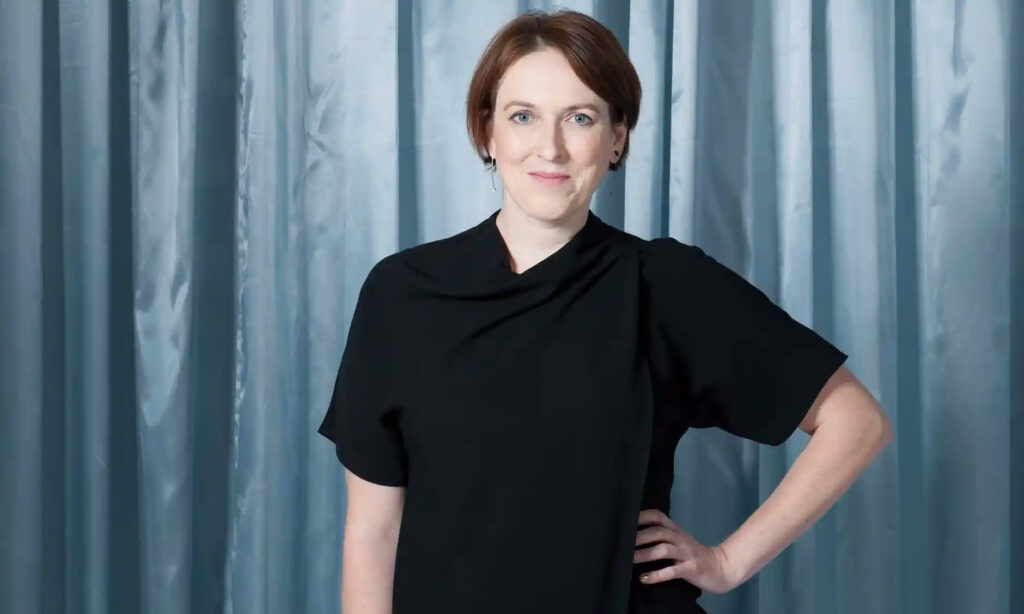When Stephanie Theobald recently gave a talk called “Sex and Judgment” at Oxford University, her new memoir, Sex Drive, sold out. In the book, Theobald explores female sexual pleasure as one of a growing band of sex-positive feminists challenging cultural expectations. They range from computer scientists to therapists, and their shared mission is to enable women to speak up about their unspoken sexual desires. The fact that Gwyneth Paltrow’s new Goop pop-up store in Notting Hill features a glass cabinet of sex toys as well as cashmere jumpers is, says Theobald, “a step in the right direction. It might still need the Trojan Horse of ‘wellness’ to get women’s sexual pleasure through the door, but it’s great that it is being talked about in the mainstream.”
In these post #MeToo days, when sex is often presented as immoral, dangerous or potentially illegal, female pleasure has, according to Theobald, become politically important. “Anger is not going to get us anywhere,” she says, which is why she is calling for a pleasure revolution. “The first sexual revolution,” she says, “was about male desire. Back in the 1970s men were still asking if women had orgasms and if they did, who cares? #MeToo was about men imposing their pleasure on women. The pleasure revolution is about women asserting their own pleasure.”
In her book, a sort of Thelma and Louise meets Eat Pray Love road trip across the States, Theobald seeks out America’s first wave of sex-positive feminist legends from the 1970s and 80s in a bid to chart a new path to sexual pleasure for herself, following the break-up of a 10-year relationship. “My usual relationship pattern was to get bored with the sex, cheat, get found out, cause chaos,” she says. “So I thought I’d be open and talk about how I needed to go off and find my desire again.” She takes readers through a countercultural America of marijuana lollipops, alien pleasure cults and “eco sexual” sexologists in a journey that becomes a voyage into her own body.

The women Theobald meets have been championing a shame-free approach to sexuality for decades. They include Betty Dodson, 89, hailed as “one of the first feminists” by Gloria Steinem and the author of Sex for One (she recently revived her 1970s masturbation classes); 85-year-old sexpert Joycelyn Elders, fired by Clinton at the height of the Aids epidemic in 1994 for saying that masturbation should be talked about in schools; and Whitney Wolfe, the founder of feminist dating app Bumble. When she arrives in California, Theobald is inducted into the outer reaches of self-pleasure as cult sex artist Annie Sprinkle teaches her how to have a tantric-style “energy orgasm”.
Language remains one of the last taboos of female sexuality, says Theobald, citing Rutgers University neuroscientist Barry Komisaruk, who studies female sexual pleasure and pain. Komisaruk was told he could have a grant for his academic paper, Vaginal Stimulation-Produced Analgesia, if he removed the word “vaginal” from the proposal. “Far from being frivolous or an ‘indulgence’,” says Theobald, “I believe it’s positively dangerous not to talk about honest female sexuality. That old chestnut that corporations love to use, ‘female empowerment’, means nothing unless sex is in the mix, too.”
Today’s “sexperts” are calling for the language of pleasure and its source to be destigmatised. “We really need to start using the correct words for our genitals,” Betty Dodson says. “We have a ‘vulva’ not a ‘vagina’; the vulva incorporates the clitoris, the inner lips, the outer lips, the urethra and the vagina – which only has sensation in it because of nerves from the clitoris. If we say ‘vagina’, then we’re leaving out the primary female sex organ, which is the clitoris.” Also often overlooked is that women have 8,000 nerve endings in their clitoris, whereas men have 4,000 in their penis. On Sex Drive’s launch day, Theobald drove around London in a yellow Mustang with a 4ft clitoris in the back seat, because, she says: “We have sports cars and men have bicycles.” French jewellery designer Anne Larue also designed a “libération sexuelle” clitoris-shaped pendant for Sex Drive, the first version of which was worn by former Paris Vogue editor Carine Roitfeld. Oscar-winning actor Emma Thompson has said that the book, “Inspired me to further heights!”
Computer scientist and Goldsmiths University lecturer Dr Kate Devlin sees a similar bias in favour of male sexual gratification in the sex tech industry. When she started writing her book, Turned On: Science, Sex and Robots in 2017, sex robots were little more than a twinkle in the eye of a tech developer. A year later Harmony sex robots, from California-based Realdoll, are rolling off the production line: perfectly sculpted plastic women. All aimed at men.
“We have this idea of a perfect artificial lover and it tends to be a very sexy woman, a femme fatale, and that’s kind of rubbish,” says Devlin, who generates ideas that appeal to women, ideas that are more sensuous, intimate and personal. “There has been talk of bringing out a male version of a sex robot, but that’s still in its infancy and, to be honest, I can’t really see the appeal – especially for women.”

Devlin launched the UK’s first sex tech hackathon in 2016, inviting 50 hackers from around the world to think about new ways to explore sex tech. “It really opened up the idea of how we can make sex technology that isn’t human-like, that isn’t some kind of artificial woman,” she says. “The sex robot market is heavily gendered at the moment. Sex robots are stuck in an engineering groove. By and large they’re dolls with a robotic head, with an AI chatbot as a personality, and they objectify women. If we can move away from this whole gender thing,” she continues, “and make technologies that are immersive or embodied or life-size, but that don’t look human, we can have smart fabrics and sensuous materials that respond to touch.”
In last year’s hackathon, one group developed a smart “shawl” to caress your body. “Another used augmented reality to create a sensuous rose petal ‘cloud’ with multiple tiny vibration motors to stimulate your skin as the petals envelope you,” says Devlin. “The hackathon threw up a ‘pea-cock’ that responded to physical arousal with a tail that fanned open when the woman was aroused.”
Another female pleasure zone is on offer at the annual Shambala music festival in Northamptonshire, where visitors were invited to sit in a giant vulva known as the Lady Garden installation. The installation started life in 2016, with the idea of creating an anatomically correct representation of female genitalia that would stimulate conversations about female sexuality while also providing a cosy place to hang out. Last year, the installation was a vulva “cave” in the woods that seated up to six people.
“You walk through the labia, through two layers of fabric curtains and we kitted it out with fur and fluff and made it really cosy inside,” says performance artist Camilla Mason, 26, a creative director of Lady Garden, and one of the group of artists behind the installation. Visitors were also challenged to find the Glitorus, an anatomically correct sculpture of a clitoris hanging up among trees, which was covered in eco-glitter. “The idea was to see if you could find it. Not everyone could, which added to the pun.”

Reactions to the installation varied, depending on the time of day and the age of the visitors, says Mason. “Almost everyone said, ‘Oh, how cool.’ It brought up all these topics of conversation that revolve around female sexuality and genitalia and just femalehood in general, which was the main agenda for me. I also wanted it to be quite funny and playful, and to tie in the idea of recycled materials, as well as educate people about the structure of the vagina and clitoris.”
During its first year, boys aged 16-18 came along. “They were a bit disrespectful and rowdy,” says Mason, “but the second year I noticed that whenever a boy, or anybody, said, ‘Oh, this is weird, what’s this about?’ somebody else, usually a girl, would say, ‘Don’t say that, have some respect.’ The girls were speaking up.”
For that generation, says Mason, “anatomy is not discussed or looked at. Even I didn’t know the actual shape of the clitoris until I looked it up. That’s not taught at school. But if you look at it, it looks like a penis, and if you think about it, when you’re a foetus it goes one way or the other. I think boys find it hard to understand that and so do girls. There’s also a taboo about masturbation, with girls not knowing how to do it. That’s also not something we talk about at school. Girls are much less likely to discover how it works for themselves and they depend on the boy. Once a girl has figured that out for herself, she can impart that knowledge to whoever she is having sex with.”
For psychosexual therapist Kate Moyle, a vulva cave is just what we need. “As a culture, we still have this level of shame, taboo and embarrassment around sexuality,” she says. She wants more women to vocalise their desires to their partners and to talk about their problems. “I consider a large part of my job as education, providing accurate information and ‘normalising the normal’. When people have a problem with sex – an inability to orgasm, for example – they are eaten up with shame because they think they are the only person in the world to feel that way.”
It’s only recently we’re starting to hear about female sexual dysfunctions, says Moyle. “Everybody has heard of erectile dysfunction, but women are only just starting to learn about conditions such as vaginismus and dyspareunia [pain during sex]. It doesn’t help that we’ve been fed a sanitised Hollywood version of female sexuality and that we’re still operating under a cloud of shame and confusion when it comes to women’s sexual plumbing: 25% of women skip their smear tests because they’re embarrassed; for young women that figure is even higher.”

Theobald also highlights the hypocrisy surrounding female sexual health, pointing out that dyspareunia only attracts one fifth of the studies compared to those on erectile dysfunction. According to the online medical search engine PubMed, there were 1,954 studies on erectile dysfunction last year compared to 393 on dyspareunia. Theobald herself began suffering from vulvodynia, meaning pain of the vulva, when she was 40.
The sexual revolution may have started more than 50 years ago, says Moyle, “but we’ve only just started to catch on to the idea that sex has to move beyond the functional to the fun. Women need to learn what sensations they enjoy, to explore their desires – listen to audio books, or read erotica.” The problem, she says, “is that we’re playing catch-up in an environment where sex is everywhere you look – everyone has a smartphone, there’s sex in almost every perfume ad – and the assumption is that everyone else is having great sex.” We need more realistic images of sex, such as advertising executive Cindy Gallop’s Make Love Not Porn website, which celebrates #realworldsex, or Anna Richards’s FrolicMe female-friendly pornography. “But it’s not just about having more realistic images,” adds Moyle. “It’s about understanding the difference between the realistic and unrealistic, because that’s where the gap is.”
If there’s one myth about sex she could bust, it would be “that men and women have different expectations of sex. We respond to a touch or something we read or watch, but there’s this idea that we should be spontaneously aroused, like the woman writhing on the sofa in the perfume ad.” And she wants it on record that it’s “not only women who want to have better sex. Men want their women to have better sex, too – we’re all in this together.”
Dominatrix Reba Maybury is committed to shifting the power balance between the sexes. The idea of the dominatrix as what she calls “a totem of power” is what drew her to the profession. “I was fascinated by this idea of a powerful woman and I’ve always been fascinated by sex and notions of shame around sexuality. I find it ridiculous how secretive people are about fetishes, because everybody has them. Some are just more extreme than others. For most people fetishes are quite subtle and sensitive.”
Maybury, aka Mistress Rebecca, is a self-styled political dominatrix. She plays “with concepts of humiliation”, using words and mind games rather than whips and costumes to cut her cohorts down to size. “I’m interested in men’s aspirations, how they feel confident and how vapid that confidence often is,” she says. Maybury also lectures in politics and critical thinking at Central Saint Martins and shows her art at the Arcadia Missa gallery in Soho (arcadiamissa.com). “The kind of job titles they want, the car they drive, the women they say they’re attracted to publicly, but not privately… I have an application form I make them fill out so that I can find out their favourite leader, their favourite band and film. Once I sweep away the capitalist achievements, then what remains are their real desires. Most men never even consider what their masculinity is based on, which is the frightening thing. All masculinity, when we look at it from a historical point of view, is to dominate women.”
A socialist of mixed-race background, Maybury only dominates white, preferably right-wing, men. “I can’t force myself to be even fictionally cruel to any other type of man. It makes the performance a lot easier,” she says. “I could never be mean to someone who wasn’t white, because the world is run by white men, isn’t it?”
She typically meets her clients online, through Tinder or Instagram, or through her radio show, Mistress Rebecca’s World, on NTS Radio, an online radio station based in Hackney. Some “relationships” remain virtual, with webcam and text exchanges. Others are conducted in public places, often in fast food restaurants and coffee shops.

“From the outside you’d never know what the dynamic was between us – we just look like two ordinary people having a coffee,” she explains. One client claimed “he was a ‘female supremacist’ and a Tory. I found that such a disgusting contradiction, I couldn’t let him get away with it. Submissives often say that all they want to do is make their mistress happy, and what could make me happier than him becoming a socialist?” Maybury has documented these exchanges in a novella, Dining with Humpty Dumpty – “about 75% of the book is real, the rest is fictionalised” – and has since developed her dominatrix work into a unique type of performance art. “I just realised I can use my job as a dominatrix to be a version of a corporate creative, like an art director, where the interns do all the work. The idea is they make the work for me and then I make the money from it when it is sold.”
True to her feminist beliefs, she is donating the profits from the next book, Bints! A Conversation Between Mistress Rebecca and the Elysium Harvester, to Swarm, the sex workers’ union. “The book is based on my conversation with this very strange misogynist. I’ve got one submissive to do the graphic design, another to do the art work, another to do the cover and another to pay for it all and all the proceeds are going to the sex workers. I’m trying to use these men to help women make money as well.”
Does she think any of the men she works with will actually change their politics as a result of her sessions? “It is my aim but it is complex. In fact, the very way that I became an ‘artist’ was through my huge frustration at how men could indulge in a fetish that had no alignment with their everyday politics – for example, a Tory who has a fetish for powerful women, but doesn’t care about sex workers’ rights and uses women as a disposable commodity.”
These activists are starting a conversation in which women are no longer sexual commodities but sexual consumers. It’s time for the pleasure revolution.
Sex Drive: On The Road to a Pleasure Revolution by Stephanie Theobald (£16.99) is available from amazon.co.uk for £12.50. See mysexdrive.org. Follow Stephanie on Instagram @dvdobald and Twitter: @stephotheo
Turned On: Science, Sex and Robots by Kate Devlin (Bloomsbury, £16.99) is available from guardianbookshop.com for £14.95.
The Lady Garden @thelady_garden and installation will be on display at the Shambala festival, 22-25 August 2019, shambalafestival.org.
Dining with Humpty Dumpty by Reba Maybury, Wet Satin Press 2017, is available at Donlon Books. Maybury’s work will be shown at NADA (New Art Dealers Alliance), in Miami, December 6-9.




